Awesome Show, Great Job!
“When I was a young boy, my parents… I grew up on a weird kind of… commune? I wouldn’t say it was a hippy commune, but it was more like a bizarre group of eccentric people, and they forced me to play as part of this big band. [The music] was mainly, like, tribal. Sort of African tribal stuff. That’s what my parents were doing.”
Although Eric Wareheim is renowned for his technological wizardry, creating bright and frenetic music videos, his musical beginnings were decidedly lo-fi. When asked what he listened to when he was growing up, Wareheim spins a story about his early listening experiences, informing us that they were purely of a live nature.
“When I was a young boy, my parents… I grew up on a weird kind of… commune? I wouldn't say it was a hippy commune, but it was more like a bizarre group of eccentric people, and they forced me to play as part of this big band. [The music] was mainly, like, tribal. Sort of African tribal stuff. That's what my parents were doing,” recalls Wareheim.
“And I didn't grow up with record players or tape players. I wasn't exposed to any outside music. So it was pretty much just, like, hardcore African tribal stuff. Mainly just didgeridoos, drums. Home-made drums. Stuff like that.”
Apparently, it wasn't until Wareheim went to Temple University and met Tim Heidecker, that his musical horizons were broadened.
Don't miss a beat with our FREE daily newsletter
“It's like I had an awakening when I left for college. I met Tim Heidecker. He started showing me all the greats… like Kenny Loggins, Santana. He really opened me up to a lot of classical rock.”
These days, his musical tastes are a little more modern and his listening habits more technologically advanced.
“For records, you know, I buy either vinyl or I download,” says Wareheim. “I love the artwork on vinyl and that's sort of a lost thing… I have a pretty good collection. I moved a couple times and lost huge portions of it, but I kept all the records that have some sentimental value to them and the important ones.”
“I would say my favourite thing right now is the new Beach House record. I'm doing a song called Wishes that's on that record, and I'm shooting that this month.”
Eric has worked with bands such as MGMT, Depeche Mode and The Bird And The Bee, creating some spectacular and wildly original music videos.
“I mean, as you can see from the videos, there's almost zero band involvement. They pretty much come to me and they know my work, so they ask me to write something for them and I write something – whatever I feel about the music, and that's what we do. I sort of pick bands that allow me to do that. I don't work with bands that have a big idea. Although, this Beach House one was co-written with Victoria, the singer from Beach House, so that's going to be a new thing for me. Which… she's so brilliant that I wanted to collaborate with her.
However, the live music experience has always remained as a part of Wareheim's listening habits. During his college days, he became a part of the Philadelphia punk scene, playing in bands such as Twelve Tone System and The Science Of. And yet, despite his punk roots, Eric told us that his preferred instrument is something a little closer to home.
“I play didgeridoo. That's all I play,” says Wareheim. “Actually, my parents have been teaching me the different ways to play didgeridoo. I've been playing since I was a young child, so I'm a master. So, it's going to be great to come down to Australia. I think in Melbourne, we just added a second show, and that's just going to be me playing the didgeridoo. Two and a half hours before we even start the show, so get ready for a really long show.
“I think it's a little bit like Stockholm Syndrome. If you're kidnapped you essentially start to love the person that kidnapped you. And the thing with the didgeridoo, I was forced to play it, but then I started to love it, and I continue to love it to this day.
“My favourite piece is this thing called Good Morning, Young Boy. That is something that I learned to play to my little brother when he wakes up. It's kind of a sensual piece, but it's also supposed to be for brotherly love, and I would wake him up every morning with my didgeridoo and he'd rise and greet me with a smile.”







